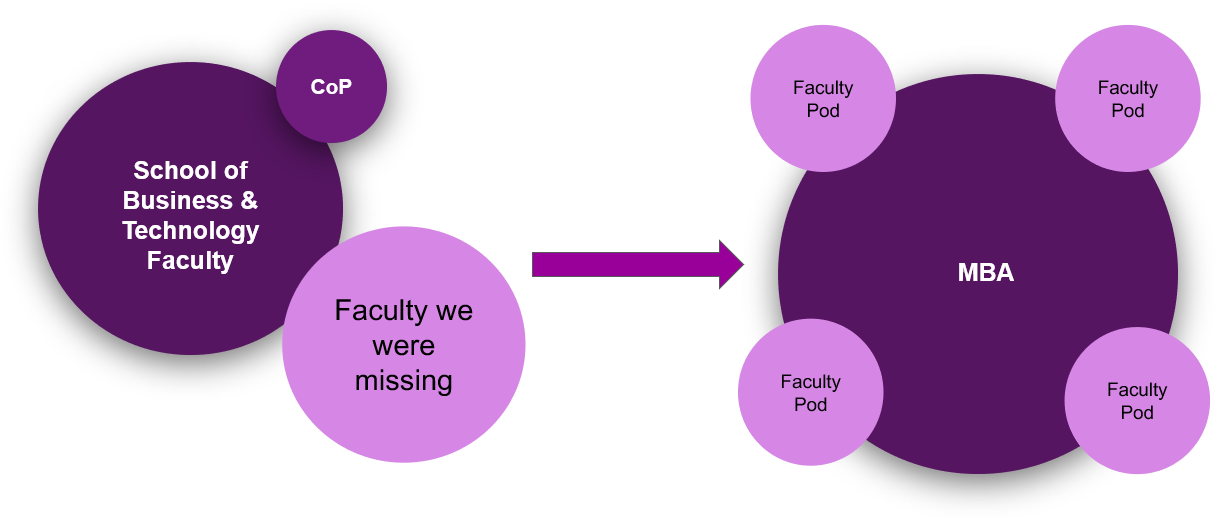Restructuring Our Faculty Learning Community
Published by: WCET | 5/14/2019
Tags: Collaboration/Community, Distance Education, Faculty, Online Learning, Professional Development
Published by: WCET | 5/14/2019
Tags: Collaboration/Community, Distance Education, Faculty, Online Learning, Professional Development
In today’s blog, we welcome Laura Sankovich from Capella University. It is increasingly difficult to create and maintain community with adjunct faculty members who work remotely and yet this is a reality in higher education. In this blog, Laura discusses a specific initiative within the MBA program — the development of Core Faculty Pods — which has proven to be successful in enhancing faculty engagement. Learn and enjoy!
-Erin Walton — contract editor for WCET
We know from surveys that it is a challenge to engage our part-time faculty and help them feel connected to the university. At Capella University, not only do our faculty work remotely, but we are typically not their only employer. We communicate expectations regarding faculty feedback, learner support resources, and programmatic changes but as we all know, email and social media can be saturated channels and thus messages may go unnoticed. In reflection, we realized that we needed a way to communicate on a more personal level to faculty.

The MBA program of Capella University employs 45 part-time, remote faculty. These faculty members may teach in both formats of the program. GuidedPath is similar to most traditional online programs in that it is quarter-based with credit-hours including pre-set deadlines, group discussions, and assessments due each week. We also have direct assessment known as FlexPath. Because these two formats run simultaneously within the MBA program, faculty start and end courses at various times throughout a quarter, each of them with different requirements regarding courseroom discussions and other programmatic distinctions. It is essential for faculty to understand the differences in both formats regarding the structure and the resources we offer to support them and our learners.
In January 2018, we created a Community of Practice (CoP) for faculty, similar to the faculty learning community described in an earlier WCET blog. We held monthly meetings to bring faculty together to develop best practices in a collaborative peer-driven environment. For the CoP, we invited all faculty in the School of Business & Technology master’s & bachelor’s programs to encourage collaboration across disciplines. Chairs encouraged faculty to attend these sessions, but were not invited to attend themselves. This was a faculty-only environment where they were invited to share whatever was on their minds. Overall, the CoP initiative was successful in improving faculty feedback quality, establishing best practices, and developing relationships across programs.
Although the feedback from this initiative was excellent, we were only reaching about 20% of faculty. And, as you might guess, the 20% in attendance were our top performers. We put a lot of effort into reaching the other 80% and invited them to share about their work outside Capella, presentations, research they were working on, and even showcase their hobbies and interests. Unfortunately, we could not incentivize those with whom we needed to engage the most. So, I brainstormed with our core faculty and together we developed Core Faculty Pods.

Core Faculty Pods is a specific initiative in the MBA program. Each core faculty has a group of courses and faculty to manage, known as a Pod. One faculty might oversee the MBA first course, capstone, and all the part-time faculty who teach in those courses while another core faculty might oversee analytics, stats, accounting, and all the faculty assigned to those courses. This design includes all online faculty teaching in the 10-week MBA GuidedPath and all FlexPath courses. To be clear, faculty are not managing performance; that remains the job of the chair.
How it Works in Application:
The goals for the pods include:
Through our pods initiative, we are reaching all faculty, not just the 20% who chose to attend our Community of Practice in the past. We are resolving operational issues more quickly with core faculty as the first point of contact and perhaps most importantly, building a faculty community within our program. We developed pods in Q4 2018, but now it is fully launched and operational. As we progress, we will continue to refine our process and learn best practices in this initiative. This is just one aspect of faculty engagement, in addition to a more holistic strategy at Capella University.
How are you engaging remote part-time faculty? What communication methods and techniques do you find most successful?

Laura Sankovich
Faculty Chair, MBA
Capella University
